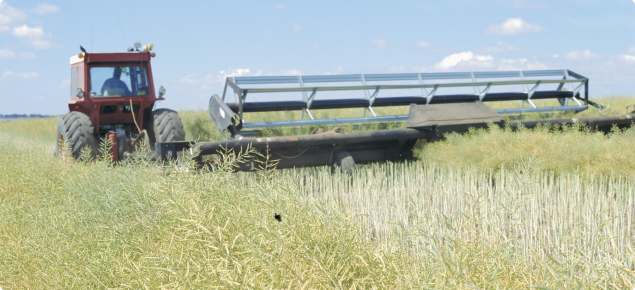Management options for preventing weed seed-set
Pasture spray-topping
Pasture spray-topping is used to prevent the domination of annual weeds (predominantly grasses) in medium-term (phase) pasture systems.
Renovation crops and pastures
These include green manuring, brown manuring, mulching and hay freezing and can be used to return crops and pastures to the soil to improve soil fertility, reduce weed burdens and increase soil organic matter.
Silage and hay
Both silage and hay production of crops and pasture can reduce the seed set of target weeds and remove viable weed seeds.
In-crop weed management for seed set control
This includes spray-topping with selective and non-selective herbicides, dessication and windrowing (swathing) to minimise the replenishment of seedbanks and/or reduce grain contamination.
Grazing
By actively managing weeds in pastures by varying grazing management techniques will maintain a balance of pasture species to maximise desirable legumes and grasses while keeping weed levels low.
Pasture spray-topping
One of the tactics for reducing annual grasses and retaining desirable species in pastures is spray-topping. This tactic involves applying a non-selective herbicide at a critical time to target weed seed set, followed by heavy grazing.
The composition of a medium term pasture changes over time. The pasture may be legume dominant in year one, but without intervention pastures become dominated by annual weeds (generally grasses). Typical grass species include annual ryegrass, silver grass, barley grass and brome grass.
These grass weeds cause:
- a build up of weed seeds in the seedbank
- reduced availability of nitrogen from pasture legume input as weeds use nitrogen reserves
- a build up of cereal root disease
- increased risk of eye injury and meat contamination in sheep and increased vegetable faults in wool (resulting from the grass weed seeds).
Spray-topping
One of the tactics for reducing annual grasses and retaining desirable species in pastures is spray-topping. This tactic involves applying a non-selective herbicide at a critical time to target weed seed set, followed by heavy grazing. Both paraquat and glyphosate can be used for spray-topping. Spray-topping pasture is possible because annual grasses become much more sensitive to non-selective knockdown herbicides during flowering. So low rates of herbicide can be used to sterilise the grass seeds, with limited effect on desirable pasture legume species.
Benefits from spray-topping
- Strategically timed spray-topping significantly reduces weed seed set, reducing the weed seed bank.
- Both paraquat and glyphosate can be used for spray-topping, allowing better management of herbicide resistance development.
- Spray-topping is a very cost effective tactic to reduce weed seed set.
- An increased proportion of legume in the pasture, resulting in improved feed value of the pasture and increased livestock production from grazing.
- Well-planned spray-topping can be used to set up pastures for high-quality forage conservation (hay or silage) during the following spring.
- Spray-topping is ideally used in the season before fallow initiation, reducing grass weeds and the risk of cereal disease carryover into the following winter crop.
- Spray-topping is very effective against barley grass (Hordeum spp.), reducing injuries to lambs’ eyes, skin and carcasses.
Issues to consider when spray-topping
- The timing of herbicide application is critical to the success of spray-topping. It must after the time when seed heads are fully emerged from the boot and before the seeds reach the dough stage (timing is slightly dependent on the herbicide used).
- Spray-topping is not an alternative to fallow spraying.
- Spray-topping alone cannot control a wide range of grass species simultaneously, because the specific timing of spray-topping will vary between species (depending on when each species produces seed heads).
- Grass weed levels determine the management 'fit' of spray-topping - monitor the pasture as grass burdens increase in response to increasing nitrogen levels.
- Winter cleaning or fallow spraying may be used to finalise the pasture phase before cropping commences.
- Spray-topping can reduce seed set in pasture legumes if the stage of development of the legume pasture coincides with the development stage of the target grass weed. See more information on the effect of spray-topping on pasture legumes.
Mechanical topping or targeted grazing
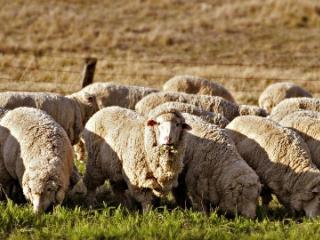
Another tactic to control weeds is mechanical topping, which refers to slashing or mowing activities late in the season to prevent development of weed seeds. It can be used as an alternative to spray-topping, particularly where resistance to knockdown herbicides is a problem. However, it is slower and more expensive than spray-topping and the plants have a greater chance of regrowing to produce seeds. Mechanical topping can alternatively be achieved by grazing, provided that a sufficient number of dry sheep are available.
Spray-topping compared with mechanical management and targeted grazing for seed set control in pastures.
| Tactic | Advantages | Disadvantages |
|---|---|---|
| Spray-topping using paraquat or glyphosate |
|
|
| Mechanical topping |
|
|
| Targeted grazing |
|
|
Renovation crops and pastures – green manuring, brown manuring, mulching and hay freezing
Renovation crops and pastures are those which are returned to the soil with the key aims of improving soil fertility, reducing weed burdens and increasing soil organic matter. Crops may be returned to the soil by burial, mulching or chemical desiccation.
Green manuring
This incorporates green plant residue into the soil with a cultivation implement. Most commonly conducted with an offset disc plough, cultivation aims to kill weeds and control seed set while building soil organic matter and nitrogen status. Green manuring has a very long history of managing weeds and building soil fertility in systems where herbicides are either not an option or not available, such as organic farming systems.
A problem with green manuring is that cultivation leads to losses of soil organic matter. Further, lighter textured soils may suffer excessive structural damage under green manuring.
The number of tillage passes required by green manuring for a successful kill may be affected by soil moisture.
Brown manuring
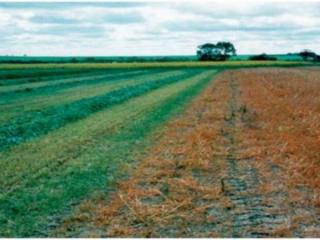
This is simply a ‘no-till’ version of green manuring, using a non-selective herbicide to desiccate the crop (and weeds) at flowering instead of using cultivation. The plant residues are left standing. This may also be a preferred option on lighter soils prone to erosion. The standing residues can be grazed after appropriate withholding periods have been observed.
Unlike green manuring, brown manuring impacts positively on soil organic matter. Brown manuring helps retain soil structure and surface cover.
Mulching
This is similar to brown manuring but involves mowing or slashing the crop or pasture and leaving the residue laying on the soil surface. This enables more soil contact with the crop residue and helps reduce soil moisture loss through evaporation. Residues may break down more rapidly as pieces are likely to be smaller than in brown manuring.
Hay freezing
This is similar to brown manuring with the additional aim of creating standing hay. In this case herbicide is applied earlier than if the crop was to be mown for conventional hay making. Hay freezing is a more reliable tactic for controlling weed seed set than conventional hay making, with the added advantage that existing boom sprays are used rather than specialised hay making equipment. The protein content and digestibility of standing hay are similar to those of conventionally baled hay.
Note that the feed value and quantity of hay freezing fodder depend on the plant species and dry matter content of the area treated. Generally, feed value drops rapidly and the treated area needs to be grazed within a few months of spraying to gain most benefit. The protein content and digestibility of fodder following hay freezing deteriorate rapidly after rain, and the fodder suffers trampling losses over time. It does, however, provide and maintain better feed value than hayed-off standing pasture. A glyphosate treated pasture in Western Australia would be expected to maintain good quality for two months after spraying. Plan to graze soon after treatment to avoid the risk of forage quality loss due to weather damage. Strip grazing with an electric or movable fence can reduce trampling loss.
Benefits of renovation cropping
- Manuring, mulching and/or hay freezing (all with regrowth control) reduce viable seed set.
- Manuring will have a beneficial effect on organic matter and soil nitrogen status. The benefit will be greater if the crop or pasture being manured has a high legume content.
- Hay freezing provides standing fodder for livestock.
- Green or brown manuring or hay freezing can be used to manage crop pests and diseases.
- Patches of weeds can be treated prior to the hectic harvest time.
- Costs of renovation cropping (income loss) can be offset by improved yield of subsequent cereal crops.
Silage and hay for weed control - crops and pastures
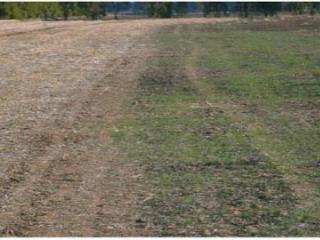
Hay and silage are options that can be used in crops and pastures where excessive numbers of weeds have survived previous weed control tactics.
Silage production and hay making reduces the viable seed set of target weeds and removes viable weed seeds so that they are not added to the soil seedbank. These weed control tactics are best suited to farms with a livestock enterprise. Hay is much more portable than silage and so hay is preferable when the product must be transported to market.
Issues to consider when using hay or silage production for weed control
Timing the cut
Timing is critical for hay and silage production to be successful as weed control tactics. Cutting too early will allow any subsequent regrowth to set viable seed and contribute to the weed seedbank. Cutting too late means that mature weed seed is likely to have already been shed, adding to the weed seedbank in the paddock.
Weed regrowth can produce enough seed to keep the seed bank topped up
It is necessary to cut early to remove weed seeds before they shed, but regrowth monitoring is very important. Bill Roy (York, 2005) showed that where paraquat was not used to control regrowth, and hay was cut 2-3 weeks after the silage production, almost no reduction in annual ryegrass numbers resulted. A knockdown herbicide or intensive grazing used after an early cut is a reliable way of controlling weed regrowth.
Is the use of hay or silage spreading weed seeds?
Hay may contain viable weed seeds, especially if the crop is cut late. Most seeds are no longer viable once they have been ensiled, but a few may survive depending on the weed species in question. Therefore, hay or silage have the potential to introduce weed seeds. Consider feeding out in dedicated areas to allow control of any weeds introduced in the feed.
| Issue | Hay | Silage |
|---|---|---|
| Prevention of viable seed addition to the weed seedbank in the paddock | Similarly effective, assuming no target weed seed production occurs before the cut and regrowth is controlled to prevent further weed seed production | Similarly effective, assuming no target weed seed production occurs before the cut and regrowth is controlled to prevent further weed seed production |
| Potential for weed seeds to be spread to other areas during feed out | Moderate to high | Low if properly ensiled |
| Potential for regrowth | Depends on growth stage of weed at time of cut | Depends on growth stage of weed at time of cut |
| Feasibility | Depends on the scale of the operation, livestock enterprises within the business, distance to end-use point and demand for the product | Depends on the scale of the operation, livestock enterprises within the business, distance to end-use point and demand for the product |
In-crop weed management for seed set control
In-crop management of weed seed set can minimise the replenishment of seedbanks and/or reduce grain contamination.
In-crop management for seed set control is achieved by intercepting the seed production of weeds that have escaped, survived or emerged after application of weed management tactics earlier in the cropping season. Controlling weed seed set contrasts with early in-crop weed management tactics, which aim to maintain or maximise crop yield by reducing weed competition. Generally, there is no grain yield benefit from seed set control, as most competition from weeds occurs earlier during the vegetative stages of the crop.
Spray-topping with selective herbicides
Selective spray-topping is the application of a post-emergent selective herbicide late in the season to prevent seed set of certain weeds. Selective spray-topping largely targets broadleaf (especially brassica) weeds and wild oats.
Correctly executed selective spray-topping will result in a 90% reduction in weed seed set. Weeds will not necessarily be killed by selective spray-topping but the growth and development of plants and subsequent seed set will be seriously impeded. The reduction in weed seed set achieved by selective spray-topping depends primarily on timing with respect to the maturity of the weed, the competitiveness of the crop and most importantly the density of the weed. Weeds at the reproductive phase are usually highly susceptible to herbicide application and, as herbicides are applied under warmer temperatures, efficacy may be enhanced.
The tactic should not be confused with pasture spray-topping, which occurs in a pasture phase, involves heavy grazing, uses a non-selective herbicide and largely targets grass weeds.
Crop topping with non-selective herbicides
Crop topping is the application of a non-selective herbicide (for example, glyphosate or paraquat) prior to harvest when the target weed is at flowering, early grain fill. Crop-topping aims to minimise production of viable weed seed while also minimising yield loss. The selectivity of the crop-topping process is dependent on a sufficient gap in physiological maturity between crop and weed.
Crop-topping improves harvest due to even maturity of crops (particularly pulses). The ideal time for crop-topping is when the annual ryegrass is just past flowering and the pulse crop is as mature as possible. Plan crop-topping at the start of the season so that suitable crop species and variety can be carefully selected to minimise yield loss. The tactic works best with early maturing pulse varieties. The best weed control will be achieved if crop-topping takes place when the weed is flowering and/or at the soft dough stage of seed development.
Crop-topping should not be performed on crops where the grain is intended for use as seed or for sprouting. Crop-topping for wild radish and other brassica weed control in current pulse varieties is not recommended because of the closely matched rate of development of weed and crop.
Currently, non-selective herbicide crop topping registrations in Western Australia are limited to use in pulse crops and predominantly target annual ryegrass. See more information on Crop-topping pulse crops.
Wiper technology
Wick wiping, blanket wiping, carpet wiping and rope wicking are all forms of weed wiping technology that aim to reduce weed seed-set by using a range of devices to wipe low volumes of concentrated herbicide onto weeds that have emerged above the crop.
Keys to successful application include:
- controlling herbicide flow to avoid dripping onto the crop
- stabilising broadacre weed wipers to avoid contact with the crop canopy
- targeting areas of low weed density. Dense patches of weeds tend to be knocked into the crop, causing transfer of herbicide from the treated weeds to the crop
- wiping in two different directions for best herbicide application
- applying only to target weeds which rise more than 25cm above the crop canopy
- consulting product labels for application rates. At the time of writing only some formulations of glyphosate have been registered for use through a weed wiper.
Crop desiccation and windrowing
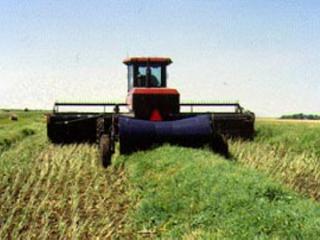
Crop desiccation and windrowing (also called swathing) are harvest aids, ignoring the growth stage of any weeds present, so they are not true weed seed set control tactics. However, in certain conditions windrowing and crop desiccation can provide significant weed management benefits. In conjunction with trash burning and the collection of residue at harvest, windrowing can minimise the addition of weed seeds to the seedbank.
Windrowing and desiccation can:
- assist harvest schedule
- encourage even ripening of crops
- increase harvest speed and efficiency
- minimise yield loss from shattering or lodging
- enhance crop yield quality
- overcome harvest problems caused by late winter or early summer weed growth
- minimise weather damage during harvest by increasing the speed of drying, while protecting the crop in the windrow
- improve the yield of following crops by halting water use by the current crop. Crops can continue to use soil water when past physiological maturity.
However:
- weed and crop regrowth (post-windrowing) must be controlled to stop seed-set
- weeds/tillers below cutting height will not be incorporated into the windrow
- windrowing in hot weather can increase losses due to shattering.

